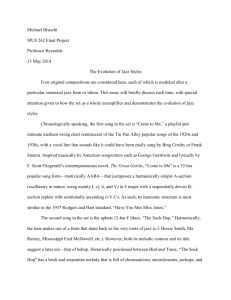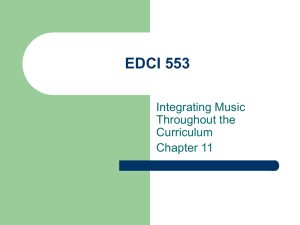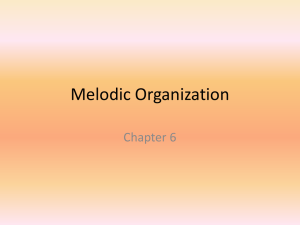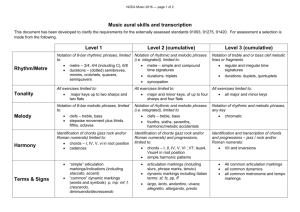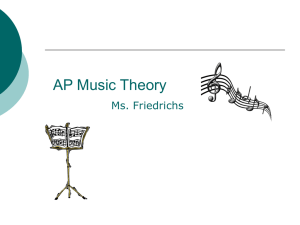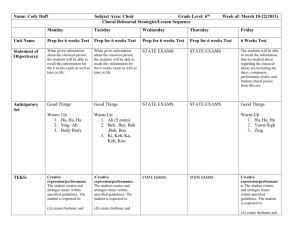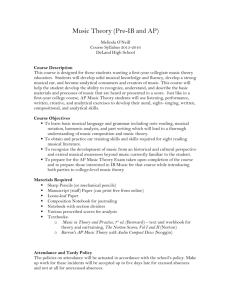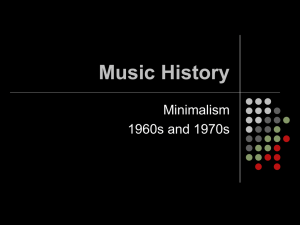Quality Rubric Survey Questions
advertisement
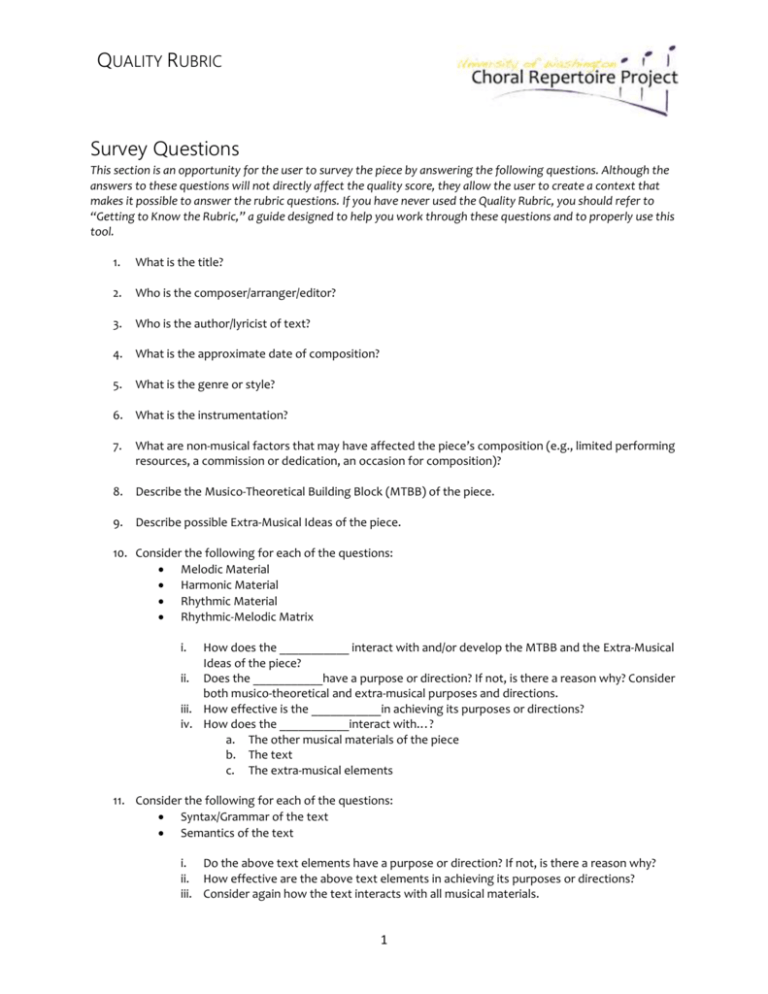
QUALITY RUBRIC Survey Questions This section is an opportunity for the user to survey the piece by answering the following questions. Although the answers to these questions will not directly affect the quality score, they allow the user to create a context that makes it possible to answer the rubric questions. If you have never used the Quality Rubric, you should refer to “Getting to Know the Rubric,” a guide designed to help you work through these questions and to properly use this tool. 1. What is the title? 2. Who is the composer/arranger/editor? 3. Who is the author/lyricist of text? 4. What is the approximate date of composition? 5. What is the genre or style? 6. What is the instrumentation? 7. What are non-musical factors that may have affected the piece’s composition (e.g., limited performing resources, a commission or dedication, an occasion for composition)? 8. Describe the Musico-Theoretical Building Block (MTBB) of the piece. 9. Describe possible Extra-Musical Ideas of the piece. 10. Consider the following for each of the questions: Melodic Material Harmonic Material Rhythmic Material Rhythmic-Melodic Matrix i. How does the ___________ interact with and/or develop the MTBB and the Extra-Musical Ideas of the piece? ii. Does the ___________have a purpose or direction? If not, is there a reason why? Consider both musico-theoretical and extra-musical purposes and directions. iii. How effective is the ___________in achieving its purposes or directions? iv. How does the ___________interact with…? a. The other musical materials of the piece b. The text c. The extra-musical elements 11. Consider the following for each of the questions: Syntax/Grammar of the text Semantics of the text i. Do the above text elements have a purpose or direction? If not, is there a reason why? ii. How effective are the above text elements in achieving its purposes or directions? iii. Consider again how the text interacts with all musical materials. 1 QUALITY RUBRIC 12. Consider the following for each of the questions: Sections Sectional Relationships i. How do the ___________ interact with and/or develop the MTBB and the Extra-Musical Ideas of the piece? ii. Do the ___________have a purpose or direction? If not, is there a reason why? Consider both musico-theoretical and extra-musical purposes and directions. iii. How effective is the ___________in achieving its purposes or directions? This rubric purposefully utilizes a neutral language. Terms that may carry with them specific connotations have been avoided so that the surveyor may bring his/her own subjectivity to the process. General definitions have been included for clarity. The definition of terms that are essential to assessing particular sections or whose meanings may be slightly different from one rater to another have been included the first time that they appear in the actual rubric. All terms that are specific to this rubric (including those already within the document) are also included in the Glossary on pages 10 and 11; all raters should become thoroughly familiar with a solid working definition for each of these terms. 2 QUALITY RUBRIC Craft The Craft section of the rubric seeks to understand and evaluate the quality of the musical and theoretical attributes of the composition. Craft is a tool/entry point toward defining and evaluating the degree of quality of the purely musical and/or theoretical elements of a composition. Craft includes the musical matrix, the text, the structure, and the miscellaneous assortment of ideas listed in the following four sections. Using the Survey Questions and details surrounding the piece to guide your answers, rate each of the statements according to the following scale: Poor 1 Below Average 2 Average 3 Above Average 4 Superior 5 1. MUSICAL AND THEORETICAL MATERIAL The interaction of all the compositional elements, yielding a compositional whole. Melodic Material: All the material throughout the piece demonstrating a succession of pitches in intervallic sequence. The material to be considered includes not only the primary “tune,” but also any succession of pitches in any voice part. 1. The melodic material interacts with and/or develops the MTBB of the piece. 1 2 3 4 5 2. The melodic material is directed toward a musico-theoretical end and/or shaped by a 1 2 3 4 5 musico-theoretical purpose. 3. The melodic material achieves its musico-theoretical end or purpose. 1 2 3 4 5 4. The melodic material supports the rhythmic material’s end or purpose. 1 2 3 4 5 5. The melodic material supports the harmonic material’s end or purpose. 1 2 3 4 5 6. The melodic material supports the rhythmic-melodic matrix’s end or purpose. 1 2 3 4 5 TOTAL /30 Harmonic Material: All the material throughout the piece demonstrating vertical combination of pitches and the succession of these combinations. This includes both the harmonic language and harmonic rhythm. 7. The harmonic material interacts with and/or develops the MTBB of the piece. 1 2 3 4 5 8. The harmonic material is directed toward a musico-theoretical end and/or shaped by a 1 2 3 4 5 musico-theoretical purpose. 9. The harmonic material achieves its musico-theoretical end or purpose. 1 2 3 4 5 10. The harmonic material supports the melodic material’s end or purpose. 1 2 3 4 5 11. The harmonic material supports the rhythmic material’s end or purpose. 1 2 3 4 5 12. The harmonic material supports the rhythmic-melodic matrix’s end or purpose. 1 2 3 4 5 TOTAL /30 Rhythmic Material: All the material throughout the piece demonstrating a succession of regular or irregular durations of sounds and silences. 13. The rhythmic material interacts with and/or develops the MTBB of the piece. 1 2 3 4 5 14. The rhythmic material is directed toward a musico-theoretical end and/or shaped by a 1 2 3 4 5 musico-theoretical purpose. 15. The rhythmic material achieves its musico-theoretical end or purpose. 1 2 3 4 5 16. The rhythmic material supports the melodic material’s end or purpose. 1 2 3 4 5 17. The rhythmic material supports the harmonic material’s end or purpose. 1 2 3 4 5 18. The rhythmic material supports the rhythmic-melodic matrix’s end or purpose. 1 2 3 4 5 TOTAL /30 3 QUALITY RUBRIC Rhythmic-Melodic Matrix: As individual rhythmic and melodic lines are combined together, they form an over-arching voice or sonority that can have its own musical and theoretical end or purpose, separate from melodic or rhythmic material alone. This interaction of melodic material as organized through rhythm among the voices is the Rhythmic-Melodic Matrix. 19. The rhythmic-melodic matrix interacts with and/or develops the MTBB of the piece. 1 2 3 4 5 20. The rhythmic-melodic matrix is directed toward a musico-theoretical end and/or shaped by 1 2 3 4 5 a purpose. 21. The rhythmic-melodic matrix achieves its musico-theoretical end or purpose. 1 2 3 4 5 TOTAL /15 2. TEXT: SYNTAX AND GRAMMAR Refers to the choice of words and the order in which they are used. Text Alone 22. 23. The text is directed toward an end or shaped by a purpose. The text achieves its end or purpose. 1 1 2 2 3 3 4 4 5 5 TOTAL Melodic Material and Text 24. The combination of textual syntax/grammar and melodic material interacts with and/or develops the MTBB of the piece. 25. The combination of textual syntax/grammar and melodic material is directed toward a musico-theoretical end and/or shaped by a musico-theoretical purpose. 26. The combination of textual syntax/grammar and melodic material achieves its musicotheoretical end or purpose. 27. The combination of melodic material and textual syntax/grammar supports the rhythmic material’s end or purpose. 28. The combination of melodic material and textual syntax/grammar supports the harmonic material’s end or purpose. 29. The combination of melodic material and textual syntax/grammar supports the rhythmicmelodic matrix’s end or purpose. TOTAL Harmonic Material and Text 30. The combination of textual syntax/grammar and harmonic material interacts with and/or develops the MTBB of the piece. 31. The combination of textual syntax/grammar and harmonic material is directed toward a musico-theoretical end and/or shaped by a musico-theoretical purpose. 32. The combination of textual syntax/grammar and harmonic material achieves its musicotheoretical end or purpose. 33. The combination of harmonic material and textual syntax/grammar supports the melodic material’s end or purpose. 34. The combination of harmonic material and textual syntax/grammar supports the rhythmic material’s end or purpose. 35. The combination of harmonic material and textual syntax/grammar supports the rhythmicmelodic matrix’s end or purpose. TOTAL Rhythmic Material and Text 36. The combination of textual syntax/grammar and rhythmic material interacts with and/or develops the MTBB of the piece. 37. The combination of textual syntax/grammar and rhythmic material is directed toward a musico-theoretical end and/or shaped by a musico-theoretical purpose. 4 /10 1 2 3 4 5 1 2 3 4 5 1 2 3 4 5 1 2 3 4 5 1 2 3 4 5 1 2 3 4 5 /30 1 2 3 4 5 1 2 3 4 5 1 2 3 4 5 1 2 3 4 5 1 2 3 4 5 1 2 3 4 5 /30 1 2 3 4 5 1 2 3 4 5 QUALITY RUBRIC 38. 39. 40. 41. The combination of textual syntax/grammar and rhythmic material achieves its musicotheoretical end or purpose. The combination of rhythmic material and textual syntax/grammar supports the melodic material’s end or purpose. The combination of rhythmic material and textual syntax/grammar supports the harmonic material’s end or purpose. The combination of rhythmic material and textual syntax/grammar supports the rhythmicmelodic matrix’s end or purpose. TOTAL Rhythmic-Melodic Matrix and Text 42. The combination of textual syntax/grammar and rhythmic-melodic matrix interacts with and/or develops the MTBB of the piece. 43. The combination of textual syntax/grammar and rhythmic-melodic matrix is directed toward a musico-theoretical end and/or shaped by a purpose. 44. The combination of textual syntax/grammar and rhythmic-melodic matrix achieves its musico-theoretical end or purpose. TOTAL 1 2 3 4 5 1 2 3 4 5 1 2 3 4 5 1 2 3 4 5 /30 1 2 3 4 5 1 2 3 4 5 1 2 3 4 5 /15 3. STRUCTURE Organization of sections and interstices as they interact with or succeed one another. Sections: Organization of musical material into definable groups, based on Craft. 45. The individual structural sections interact with and/or develop the MTBB of the piece. 46. 47. The individual structural sections organize the musical matrix such that the matrix is directed toward a musico-theoretical end and/or shaped by a purpose. The individual structural sections organize the musical matrix such that the matrix achieves its musico-theoretical end or purpose. TOTAL Sectional Relationships: The interaction and succession of organizational identities among sections. 48. The relationships between/among sections interact with and/or develop the MTBB of the piece. 49. The relationships between/among sections organize the musical matrix such that the matrix is directed toward a musico-theoretical end and/or shaped by a purpose. 50. The relationships between/among sections organize the musical matrix such that the matrix achieves its musico-theoretical end or purpose. TOTAL Interstices: A small structural space or interval that allows the music to pass from section to section. 51. The interstices link the sections such that the piece as a whole is directed toward a musicotheoretical end and/or shaped by a musico-theoretical purpose. TOTAL 1 2 3 4 5 1 2 3 4 5 1 2 3 4 5 /15 1 2 3 4 5 1 2 3 4 5 1 2 3 4 5 /15 1 2 3 4 5 /5 4. MISCELLANY Miscellany 52. 53. 54. The multiplicity of timbres is appropriate in relation to the Craft. 1 2 3 4 5 The texture is appropriate in relation to the Craft. The work carefully utilizes the ranges and capabilities of the voice and other instruments. 1 1 2 2 3 3 4 4 5 5 TOTAL 5 /15 QUALITY RUBRIC Communicability The Communicability section of the rubric seeks to understand and evaluate the quality of the composition’s ability to connect beyond itself. Communicability evaluates the ability of the piece to connect with ideas beyond Craft. Please rate the following statements according to your understanding of the piece based on the scale below: Poor 1 Below Average 2 Average 3 Above Average 4 Superior 5 1. MUSICAL AND THEORETICAL MATERIALS Melodic Material 55. The melodic material is able to interact with and/or develop an Extra-Musical Idea. 56. The melodic material is directed toward an extra-musical end and/or shaped by an extramusical purpose. 57. The melodic material achieves its extra-musical end or purpose. 58. The melodic material supports the rhythmic material’s extra-musical end or purpose. 59. The melodic material supports the harmonic material’s extra-musical end or purpose. 60. The melodic material supports the rhythmic-melodic matrix’s extra-musical end or purpose. TOTAL Harmonic Material 61. The harmonic material is able to interact with and/or develop an Extra-Musical Idea. 62. The harmonic material is directed toward an extra-musical end and/or shaped by an extramusical purpose. 63. The harmonic material achieves its extra-musical end or purpose. 64. The harmonic material supports the rhythmic material’s extra-musical end or purpose. 65. The harmonic material supports the melodic material’s extra-musical end or purpose. 66. The harmonic material supports the rhythmic-melodic matrix’s extra-musical end or purpose. TOTAL Rhythmic Material 67. The rhythmic material is able to interact with and/or develop an Extra-Musical Idea. 68. The rhythmic material is directed toward an extra-musical end and/or shaped by an extramusical purpose. 69. The rhythmic material achieves its extra-musical end or purpose. 70. The rhythmic material supports the melodic material’s extra-musical end or purpose. 71. The rhythmic material supports the harmonic material’s extra-musical end or purpose. 72. The rhythmic material supports the rhythmic-melodic matrix’s extra-musical end or purpose. TOTAL Rhythmic-Melodic Matrix 73. The rhythmic-melodic matrix is able to interact with and/or develop an Extra-Musical Idea. 74. The rhythmic-melodic matrix is directed toward an extra-musical end and/or shaped by an extra-musical purpose. 75. The rhythmic-melodic matrix achieves its extra-musical end or purpose. TOTAL 6 1 1 2 2 3 3 4 4 5 5 1 1 1 1 2 2 2 2 3 3 3 3 4 4 4 4 5 5 5 5 /30 1 1 2 2 3 3 4 4 5 5 1 1 1 1 2 2 2 2 3 3 3 3 4 4 4 4 5 5 5 5 /30 1 1 2 2 3 3 4 4 5 5 1 1 1 1 2 2 2 2 3 3 3 3 4 4 4 4 5 5 5 5 /30 1 1 2 2 3 3 4 4 5 5 1 2 3 4 5 /15 QUALITY RUBRIC 2. TEXT: SEMANTICS Refers to the meaning of each of the words and the overarching ideas the words create (through phrases, sentences, stanzas/paragraphs, and sections). Melodic Material and Text 76. The combination of text’s semantics and melodic material interacts with and/or develops an Extra-Musical Idea. 77. The combination of text’s semantics and melodic material is directed toward an extramusical end and/or shaped by an extra-musical purpose. 78. The combination of text’s semantics and melodic material achieves its extra-musical end or purpose. 79. The combination of melodic material and text’s semantics supports the melodic material’s extra-musical end or purpose. 80. The combination of melodic material and text’s semantics supports the harmonic material’s extra-musical end or purpose. 81. The combination of melodic material and text’s semantics supports the rhythmic-melodic matrix’s extra-musical end or purpose. TOTAL Harmonic Material and Text 82. The combination of text’s semantics and harmonic material interacts with and/or develops an Extra-Musical Idea. 83. The combination of text’s semantics and harmonic material is directed toward an extramusical end and/or shaped by an extra-musical purpose. 84. The combination of text’s semantics and harmonic material achieves its extra-musical end or purpose. 85. The combination of harmonic material and text’s semantics supports the melodic material’s extra-musical end or purpose. 86. The combination of harmonic material and text’s semantics supports the rhythmic material’s extra-musical end or purpose. 87. The combination of harmonic material and text’s semantics supports the rhythmic-melodic matrix’s extra-musical end or purpose. TOTAL Rhythmic Material and Text 88. The combination of text’s semantics and rhythmic material interacts with and/or develops an Extra-Musical Idea. 89. The combination of text’s semantics and rhythmic material is directed toward an extramusical end and/or shaped by an extra-musical purpose. 90. The combination of text’s semantics and rhythmic material achieves its extra-musical end or purpose. 91. The combination of rhythmic material and text’s semantics supports the melodic material’s extra-musical end or purpose. 92. The combination of rhythmic material and text’s semantics supports the harmonic material’s extra-musical end or purpose. 93. The combination of rhythmic material and text’s semantics supports the rhythmic-melodic matrix’s extra-musical end or purpose. TOTAL Rhythmic-Melodic Matrix and Text 94. The combination of text’s semantics and rhythmic-melodic matrix interacts with and/or develops an Extra-Musical Idea. 95. The combination of text’s semantics and rhythmic-melodic matrix is directed toward an 7 1 2 3 4 5 1 2 3 4 5 1 2 3 4 5 1 2 3 4 5 1 2 3 4 5 1 2 3 4 5 /30 1 2 3 4 5 1 2 3 4 5 1 2 3 4 5 1 2 3 4 5 1 2 3 4 5 1 2 3 4 5 /30 1 2 3 4 5 1 2 3 4 5 1 2 3 4 5 1 2 3 4 5 1 2 3 4 5 1 2 3 4 5 /30 1 2 3 4 5 1 2 3 4 5 QUALITY RUBRIC 96. extra-musical end and/or shaped by an extra-musical purpose. The combination of text’s semantics and rhythmic-melodic matrix achieves its extramusical end or purpose. 1 2 3 4 5 TOTAL /30 3. STRUCTURE Sections 97. 98. 99. The individual structural sections interact with and/or develop an Extra-Musical Idea. The individual structural sections organize the musical matrix such that the matrix is directed toward an extra-musical end and/or shaped by as purpose. The individual structural sections organize the musical matrix such that the matrix achieves its extra-musical end or purpose. TOTAL Sectional Relationships 100. The relationships between/among sections interact with and/or develop an extra-musical building block of the piece. 101. The relationships between/among sections organize the musical matrix such that the matrix is directed toward an extra-musical end and/or shaped by an extra-musical purpose. 102. The relationships between/among sections organize the musical matrix such that the matrix achieves its extra-musical end or purpose. TOTAL Interstice 103. The interstices link the sections such that the piece as a whole is directed toward an extramusical end and/or shaped by an extra-musical purpose. 1 1 2 2 3 3 4 4 5 5 1 2 3 4 5 /15 1 2 3 4 5 1 2 3 4 5 1 2 3 4 5 /15 1 2 3 4 5 TOTAL /5 4. MISCELLANY Miscellany 104. 105. The multiplicity of timbres appropriately colors the Extra-Musical Idea. The use of texture is appropriate to the Extra-Musical Idea. 1 1 TOTAL 8 2 2 3 3 4 4 5 5 /10 QUALITY RUBRIC Score Sheet CRAFT COMMUNICABILITY Melodic Material Melodic Material Harmonic Material Harmonic Material Rhythmic Material Rhythmic Material Rhythmic-Melodic Matrix Rhythmic-Melodic Matrix Text Alone Melodic Material and Text Harmonic Material and Text Rhythmic Material and Text Rhythmic-Melodic and Text Melodic Material and Text Harmonic Material and Text Rhythmic Material and Text Rhythmic-Melodic and Text Sections Sections Sectional Relationships Sectional Relationships Interstice Interstice Miscellany Miscellany SUBTOTAL Divided by Number of Questions SUBTOTAL 54 Divided by Number of Questions COMMUNICABILITY SCORE CRAFT SCORE CRAFT SCORE + COMMUNICABILITY SCORE TOTAL 51 _______ _______ _______ 2 = OVERALL QUALITY SCORE 9 QUALITY RUBRIC Glossary Communicability: The Communicability section of the rubric seeks to understand and evaluate the quality of the composition’s ability to connect beyond itself. Communicability evaluates the ability of the piece to connect with ideas beyond Craft. Craft: The Craft section of the rubric seeks to understand and evaluate the quality of the musical and theoretical attributes of the composition. Craft is a tool/entry point toward defining and evaluating the degree of quality of the purely musical and/or theoretical elements of a composition. Craft includes the musical matrix, the text, the structure, and the miscellaneous assortment of ideas listed in the following four sections. Extra-Musical: Any elements that fall outside of Craft. Harmonic Language: The systemization and intelligibility of harmonies. Harmonic Material: Harmonic material consists of all the material throughout the piece demonstrating vertical combination of pitches and the succession of these combinations. This includes both the harmonic language and harmonic rhythm (or the rate at which harmonies change). Harmonic Rhythm: The rate of harmonic change. Interstice: A small structural space or interval that allows the music to pass from section to section. Melodic Material: All the material throughout the piece demonstrating a succession of pitches in intervallic sequence. The material to be considered includes not only the primary “tune,” but any succession of pitches in any voice or part. Meter: The time signature chosen by the composer. Musical Matrix: The interaction of all the compositional elements, yielding a compositional whole. Musico-theoretical – Music theory based Musico-Theoretical Building Block (MTBB) – The melodic, motivic, rhythmic, harmonic, theoretical, or other ideas that are comprised of solely of musical material (notes, rhythms, dynamics, articulations, harmony, etc) which govern the composition and development of the piece. Rhythmic Material: All the material throughout the piece demonstrating a succession of regular or irregular durations of sounds and silences. Rhythmic-Melodic Matrix: As individual rhythmic and melodic lines are combined together, they form an over-arching voice or sonority that can have its own musical and theoretical end or purpose, 10 QUALITY RUBRIC separate from melodic or rhythmic material alone. This interaction of melodic material as organized through rhythm among the voices is the Rhythmic-Melodic Matrix. Sectional Relationships: The interaction and succession of organizational identities among sections. Sections: The organization of musical material into definable groups, based on Craft. Semantics: Refers to the meaning of each of the words and the overarching ideas the words create (through phrases, sentences, stanzas/paragraphs, and sections). Structure: Organization of sections and interstices as they interact with or succeed one another. Syntax/Grammar: Refers to the choice of words and the order in which they are used. Texture: The combination of activity (within an individual voice) and density (among all voices) in the Craft. Timbre: The combination of vocal and instrumental sound and the resultant colors. Voice: A single part of the musico-theoretical matrix, to be played on or sung by (a) like instrument(s) or voice(s), which is the carrier of the rhythmic-melodic material, and which, in combination, create the possibility of harmony. 11

